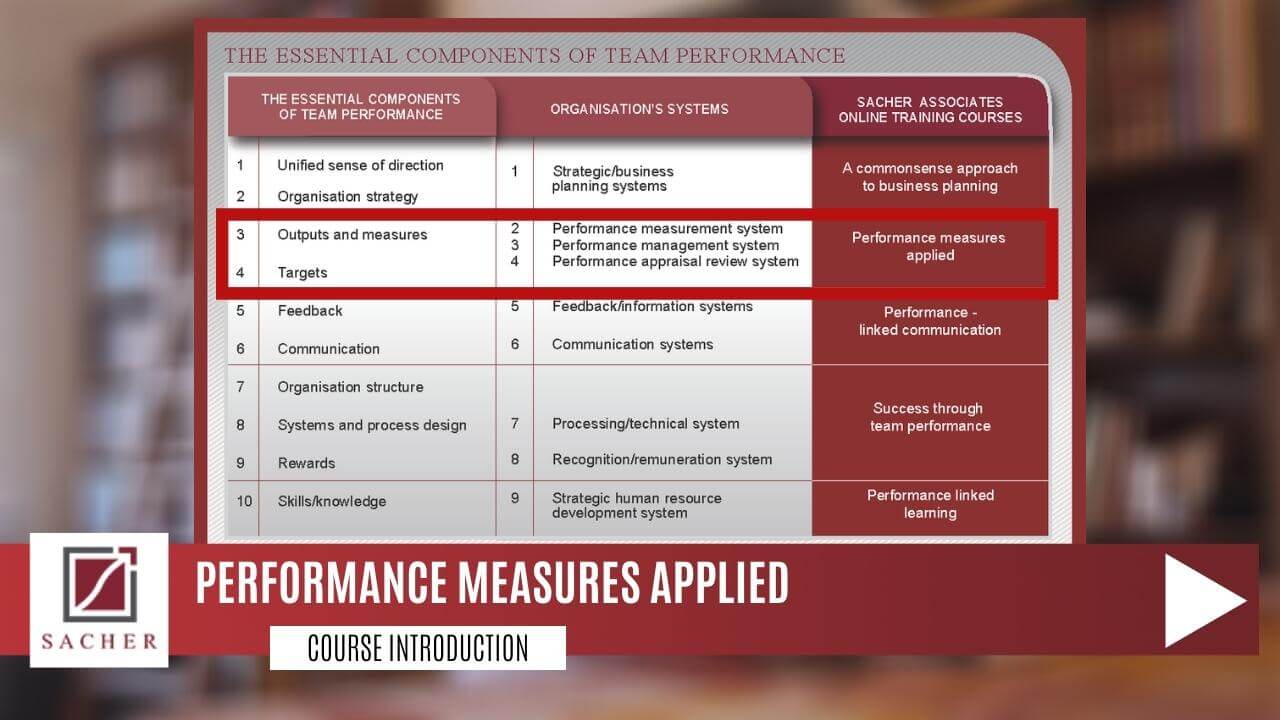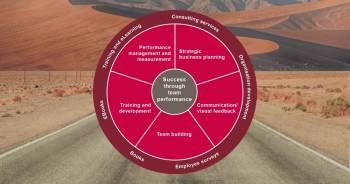BALANCE SCORECARD
What gets measured, gets managed.
Sacher Associates can transform your organisation by implementing The Essential Components of Team Performance. Book an obligation free clarity call now to find out how.
If an organization is to perform, the people who have expectations or place demands on that system have to be satisfied. These people’s expectations may be different, even conflicting. For example, customer demands may differ from employee demands; shareholder demands may conflict with the demands of environmental groups, and so on. A system is required to identify and give due weight to all the relevant stakeholders in the organization. Many organizations focus on one group of stakeholders at the expense of other groups. Organizations are now arriving at the concept of total stakeholder satisfaction which is defined as satisfying the demands and expectations of all the stakeholders of a given organization or team. To optimise the organization system there needs to be an emphasis on the rigorously measured demands and expectations of all stakeholders. To optimise the overall business system, team-based performance systems need to be based on outputs, measures, and targets that balance the potentially conflicting requirements of customers and stakeholders. Total stakeholder satisfaction is a balancing act between, for example, short-term profit and long-term gain, or customer retention and employee satisfaction. Experience suggests the creation of a balanced scorecard of targets upon which the other performance systems can be based is the best way to proceed.
Put simply, a balanced scorecard is a weighted set of outputs, measures, and targets that reflect the complex mix of requirements needed to achieve total stakeholder satisfaction. For example, targets covering profit and return-on-investment would satisfy owners and shareholders while targets on customer satisfaction, employee satisfaction, cost and cycle time would be weighted to reflect the needs of the other stakeholders. The balanced scorecard, originally popularised by Kaplan and Norton, has become synonymous with a systematic approach to implementing strategy. It can be used as a framework to translate the organization's vision, mission, values and strategic goals into the everyday outputs, measures, and targets of the people doing the work. Many strategic plans do not work well because they are not implemented. The workforces of many companies go about their daily business activities unaware of the fact that the company even has a business plan. As a result, there is no relationship between the plans and the workers' activities.
Unfortunately, many businesses lack a mechanism or system to translate their abstract visions and plans into measurable outputs, so that every person in the organisation knows exactly what outputs they are expected to produce and how those outputs are to be measured. This would ensure that everybody knows exactly what they have to do on Monday morning to achieve results. This module outlines the balanced scorecard process to hierarchically and mathematically connect the organisation's vision to the daily actions of the people doing the work. It is a process to implement the strategy.
The starting point would be the identification of the business unit, and the development of the business unit's strategic plan. This would involve the development of a vision, mission, strategy, outputs, measures, targets and feedback systems for the business unit. These are then cascaded down the business unit in such a way that it is localised, meaningful, understood and owned by every team in the business unit. The cascading process ensures alignment and linkage between the business units strategic goals and the outputs, measures, targets and action plans of the people doing the work.
Such a process enables resource allocations, annual budgets and strategic decisions all to be driven by the strategy. Performance reviews can be used to monitor individual performance which in turn monitors organisational performance. Reward systems can be designed to reward organisational performance achievement. The vital link between performance management and strategic goals can be made. The performance management system becomes a process to implement the strategy.
Have a look at our Performance Measures Applied online course for more information on how to implement a Balanced Scorecard.
Our Clients:







Why choose Us?
We collaborate with our clients to achieve sustainable and measurable performance improvements through your people. We facilitate a work environment or culture that enables continuous improvement and sustained excellence.
We partner with you to achieve productivity improvements through teams, at all levels. Our role is not to run courses or perform other activities that your internal people could do better. Rather, we work with you to achieve the highest levels of organizational effectiveness, resulting in sustained bottom-line improvements.
We are experienced, implementation specialists.
OUR LATEST BLOGS
-
Read more...
 How to fine-tune your performance management system
How to fine-tune your performance management system
Do you struggle to control the delivery of measurable results by the people that you lead? Wouldn't it be great if they stopped micromanaging each other, and were more empowered and engaged, and less apathetic? What…
-
Read more...
 What do I do on Monday morning?
What do I do on Monday morning?
What do I do on Monday morning? This phrase has stayed with me for more than 20 years.
-
Read more...
 Workplace Wars. How to win.
Workplace Wars. How to win.
No problem in this world or beyond can withstand human beings, blessed with limitless potential, working effectively in organizations. If people are productive at work, they are happier not just at work, but with their families…
-
Read more...
 How to implement a unified sense of direction: The 10 Musts.
How to implement a unified sense of direction: The 10 Musts.
What is a unified sense of direction and how do you develop one? The first essential component of team performance is a unified sense of direction. A unified sense of direction can best be summed up…
-
Read more...
 The five pathways to Organizational Effectiveness
The five pathways to Organizational Effectiveness
It is very easy to lose your way on the road to organizational effectiveness. It can be dispiriting to work in an environment that lacks clear direction, coordination, and role clarity.
-
Read more...
 The Future of Organization Effectiveness
The Future of Organization Effectiveness
Do your team and organization have a unified sense of direction, (the unique contribution of the leader), a strategic plan effectively being implemented, a bulletproof measurement and performance management system that provides role clarity and accountability?
















